A typical Canadian house showcases a rich blend of architectural styles that reflect the nation's diverse geography and cultural influences. You might find Colonial homes with symmetrical designs on the East Coast, while Prairie provinces often feature open Ranch or Split-level designs. In urban areas, sleek Modern houses highlight clean lines and large windows. On the West Coast, you'll see sustainable designs built to integrate with nature. Whether you're drawn to Victorian ornamentation or cozy log cabins in the North, each style tells a unique story. Discovering more about these variations can help you appreciate the charm of Canadian homes even further.
Key Takeaways
- Canadian houses showcase diverse architectural styles, including Colonial, Victorian, Modern, and Prairie Style, influenced by geography and climate.
- East Coast homes typically feature wood materials with symmetrical designs, reflecting Colonial and Cape Cod influences.
- Prairie provinces highlight Ranch and Split-level homes, designed for spacious landscapes and promoting indoor-outdoor living.
- West Coast architecture emphasizes sustainability, integrating natural materials and energy-efficient features to withstand the coastal climate.
- Northern regions often utilize log cabins, reflecting indigenous architecture and adaptability to harsh environments.
Overview of Canadian Architecture

When you explore Canadian architecture, you'll discover a rich tapestry of styles shaped by the country's diverse geography and cultural influences.
Canadian architecture features an array of home styles, from Colonial and Victorian to Modern and Prairie Style. Each style reflects regional variations, showcasing local materials and histories.
For instance, the East Coast often highlights wood in Colonial and Cape Cod homes, while the Prairies embrace the simplicity of Prairie Style.
Contemporary designs frequently draw inspiration from these traditional forms but focus on energy efficiency and sustainable materials.
Popular House Styles
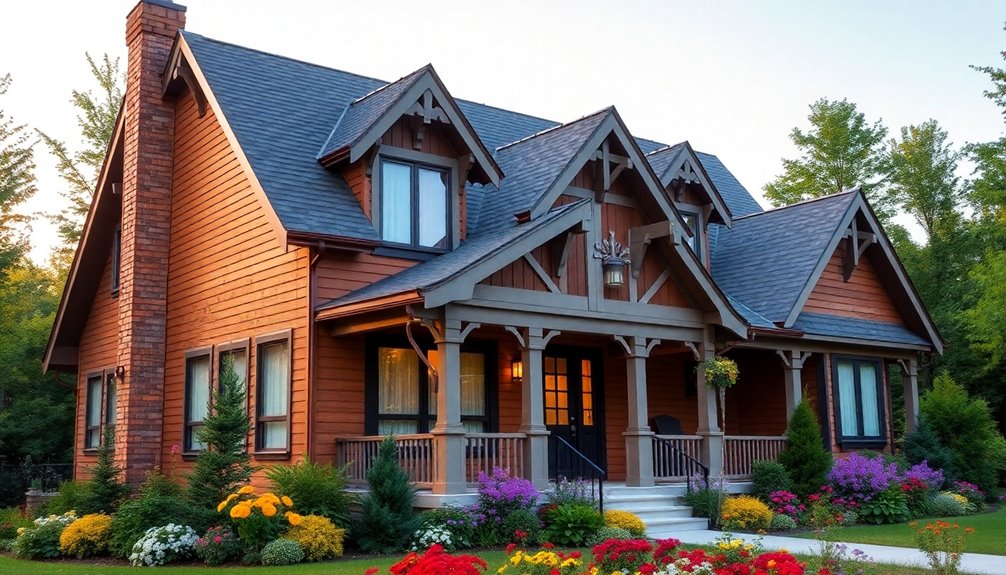
Canadian house styles showcase an impressive variety shaped by cultural influences and geographical diversity.
Among the popular styles, Victorian homes stand out with their ornate detailing, steep roofs, and unique features like bay windows and stained glass.
In contrast, the Modern Style emphasizes clean lines and large windows, appealing to those in urban settings.
The Ranch style offers single-story designs that blend indoor and outdoor living, while the Bungalow Style is known for its open floor plans, making it accessible for families and retirees alike.
Additionally, regional styles, such as Prairie Style in the Prairies and coastal designs in British Columbia, highlight how local geography and climate influence architectural design across Canada.
Each style reflects the rich tapestry of Canadian culture.
Modern and Contemporary Designs
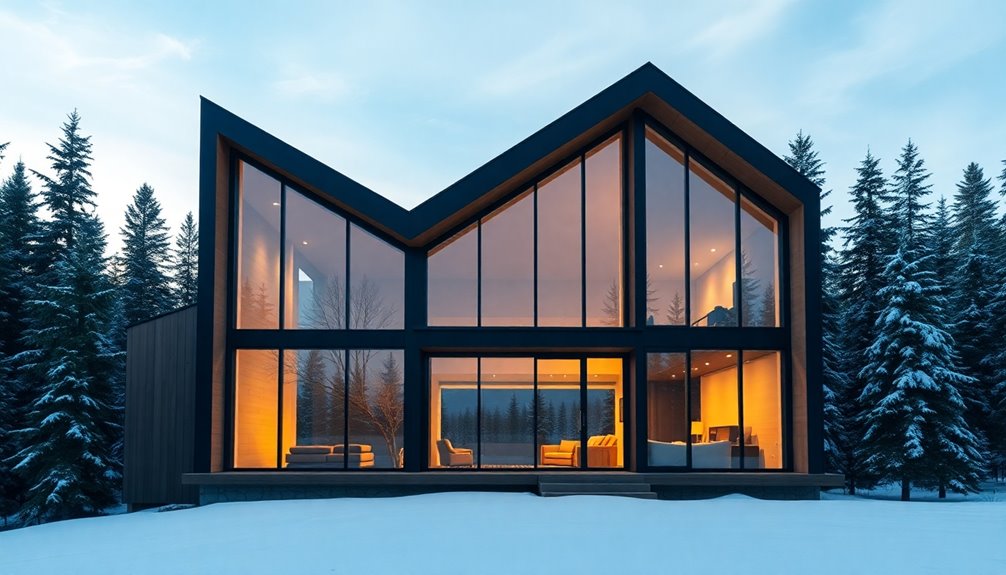
As you explore modern and contemporary designs, you'll find that these styles prioritize functionality and simplicity, creating spaces that feel both inviting and stylish.
Modern designs emphasize clean lines and minimal ornamentation, often featuring open floor plans and large windows that flood interiors with natural light—perfect for urban areas.
Contemporary homes frequently incorporate sustainable materials and energy-efficient features, showcasing a commitment to eco-friendly living.
The West Coast Modern style highlights multipurpose living spaces with bold geometric shapes, while Modern Farmhouse designs blend traditional charm with modern functionality using reclaimed wood and exposed beams.
In cities like Ottawa and Toronto, innovative use of space makes these homes appealing to younger generations seeking contemporary housing solutions.
Traditional and Historical Styles

While exploring the rich tapestry of traditional and historical house styles, you'll discover a variety of designs that reflect Canada's diverse architectural heritage.
The Colonial Style, popular in eastern Canada, showcases symmetrical designs with gabled roofs and central entrances.
In contrast, Victorian Style homes, flourishing in the late 19th century, are known for their ornate detailing and vibrant colors, featuring bay windows and stained glass.
You'll also find Cottage Style homes with their charming, asymmetrical layouts and large porches.
The Gothic Revival style boasts sharply peaked roofs and slender windows, while Chateau Style homes exhibit steep rooftops and tall turrets, reminiscent of Scottish and French architecture.
Each of these traditional styles adds unique character to Canada's architectural landscape.
Regional Variations

When you explore Canada's regional house styles, you'll notice how the East Coast leans towards Colonial and Cape Cod designs, deeply rooted in its maritime history.
In the Prairie provinces, Ranch and Split-level homes dominate, perfectly suited for their vast landscapes.
Meanwhile, the West Coast impresses with innovative, sustainable architecture that harmonizes with its stunning natural surroundings.
East Coast Characteristics
East Coast homes stand out for their unique architectural styles, primarily influenced by Colonial and Cape Cod designs. You'll notice the symmetrical designs and steep roofs that define these residences, offering a classic look.
Many houses flaunt wooden clapboard siding, perfectly suited for the region's varied climate and sea air. Large porches are a common feature, providing outdoor living space while protecting entrances from harsh weather.
Additionally, coastal properties often have elevated foundations to counteract flooding, reflecting a practical approach to maritime conditions. The rich cultural heritage of the East Coast is evident in its residential designs, showcasing historical influences from British and French colonial architecture, which adds to the region's charm and character.
Prairie Design Influences
Prairie design influences in Canada create a seamless blend between architecture and the expansive landscapes they inhabit. Characterized by low-pitched roofs, wide overhangs, and horizontal lines, this style emphasizes a strong connection to nature.
You'll often find open floor plans and large windows that maximize natural light and outdoor views, perfect for the vast prairies. Homes typically incorporate natural materials like wood and stone, promoting harmony with nature.
Regional variations may reflect elements of Indigenous architecture, ensuring comfort and energy efficiency while adapting to harsh Canadian winters. Built-in furniture and functional spaces cater to the practical needs of families, making Prairie design a thoughtful choice for those living in rural areas.
West Coast Innovations
As you explore West Coast innovations in home design, you'll notice a striking emphasis on sustainability and natural integration.
The West Coast style often embraces modernist designs that prioritize energy efficiency, essential for the coastal climate.
Key features include:
- Large windows that flood spaces with natural light
- Open floor plans for seamless flow and functionality
- Outdoor living spaces, like expansive decks and patios, enhancing lifestyle connections
- Locally sourced materials, such as cedar and stone, reflecting environmental responsibility
The West Coast Modern style has gained popularity, blending artistic expression with practical living.
This approach creates homes that not only look stunning but also harmonize with their surroundings, making it a favored choice among homeowners in British Columbia and beyond.
Unique Characteristics of Canadian Homes
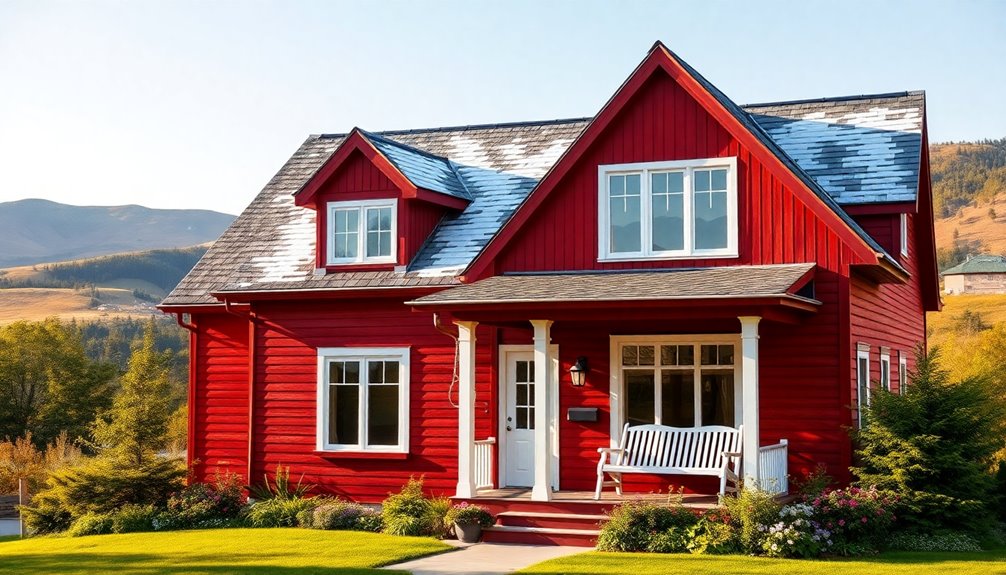
When you explore Canadian homes, you'll notice a remarkable blend of architectural styles that reflect the country's diverse regions and historical influences.
Many of these houses prioritize sustainable design, using eco-friendly materials and maximizing natural light.
This unique combination not only showcases Canada's rich heritage but also highlights its commitment to energy efficiency.
Architectural Diversity Across Regions
While exploring the architectural diversity of Canadian homes, you'll discover a fascinating array of styles shaped by geography, climate, and cultural heritage.
This regional variation results in unique designs that reflect local traditions and environmental needs:
- East Coast: Colonial and Cape Cod styles dominate, showcasing historical influences.
- Prairie Provinces: Ranch and Split-level designs offer practical living space for families.
- West Coast: Modernist designs emphasize sustainability and large windows for natural light.
- Northern Regions: Log cabins highlight indigenous influences and adaptability to harsh weather.
These architectural styles reveal how Canada's diverse landscapes and cultures have shaped its homes, making each region distinct and vibrant in its own right.
Sustainable Design Features
Canada's unique architectural styles not only reflect regional diversity but also embrace sustainable design features that enhance livability and environmental responsibility.
Many homes incorporate energy-efficient features like high-performance windows and insulation, helping you reduce heating costs. You'll often find locally sourced materials, which minimize transportation emissions and support local economies.
Roof designs frequently include overhangs and sloped angles to manage snow load while optimizing natural light and reducing heating and cooling demands.
Innovative water management systems, such as rainwater harvesting and permeable paving, promote conservation and lessen runoff.
Plus, the integration of smart home technology allows you to monitor and control energy usage, contributing to a more sustainable living environment that aligns with modern values.
Historical Influences on Styles
Although influenced by various historical architectural movements, Canadian home styles uniquely reflect the nation's cultural diversity and regional climates. The blend of British, French, and Indigenous designs gives rise to distinctive characteristics in homes across the country.
Key features include:
- Victorian style with ornate detailing and asymmetrical shapes
- Gothic Revival architecture showcasing pointed arches and intricate stonework
- Craftsman style, focusing on craftsmanship and natural materials
- Chateau-style homes featuring steep rooftops and tall turrets
These styles not only represent Canada's rich history but also adapt to diverse regional climates, ensuring that homes remain functional and aesthetically pleasing throughout the seasons.
Embracing these influences, Canadian home styles tell a story of resilience and creativity.
Influences of Climate on Design
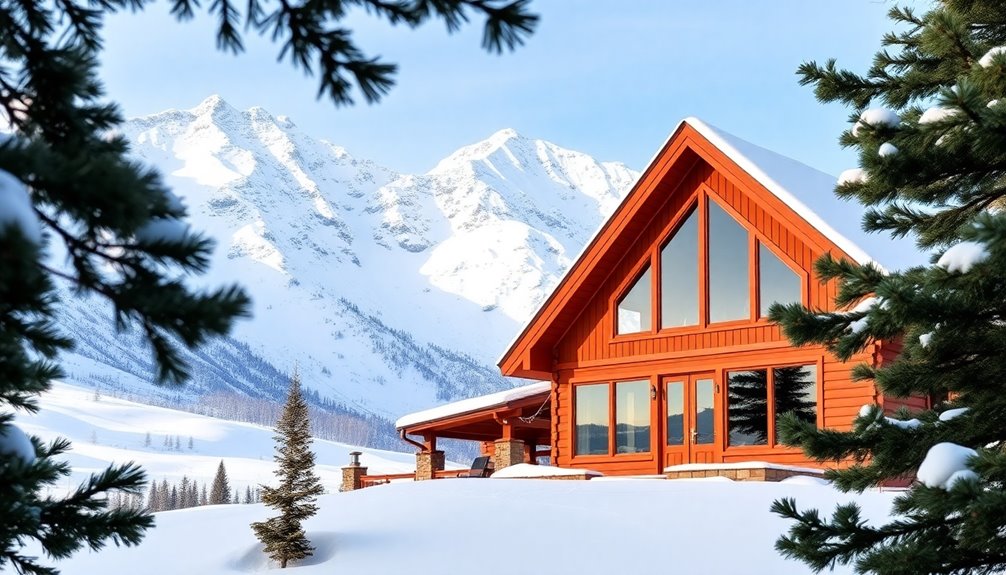
When you explore typical Canadian house styles, you'll notice that climate plays a crucial role in their design. In colder regions, homes often feature steep roofs and overhangs to shed snow and protect against heavy precipitation.
Many northern homes utilize wood and stone for insulation, effectively retaining heat during long winters. Large windows are common in contemporary designs, enhancing natural light and promoting passive solar heating, making them energy efficient.
Coastal homes in British Columbia are built with durable materials and raised structures to tackle climate challenges like heavy rain and flooding.
Meanwhile, ranch-style designs in the Prairie provinces often incorporate open floor plans, offering better airflow and cooling during hot summer months while blending seamlessly with the landscape.
Home Buying Considerations
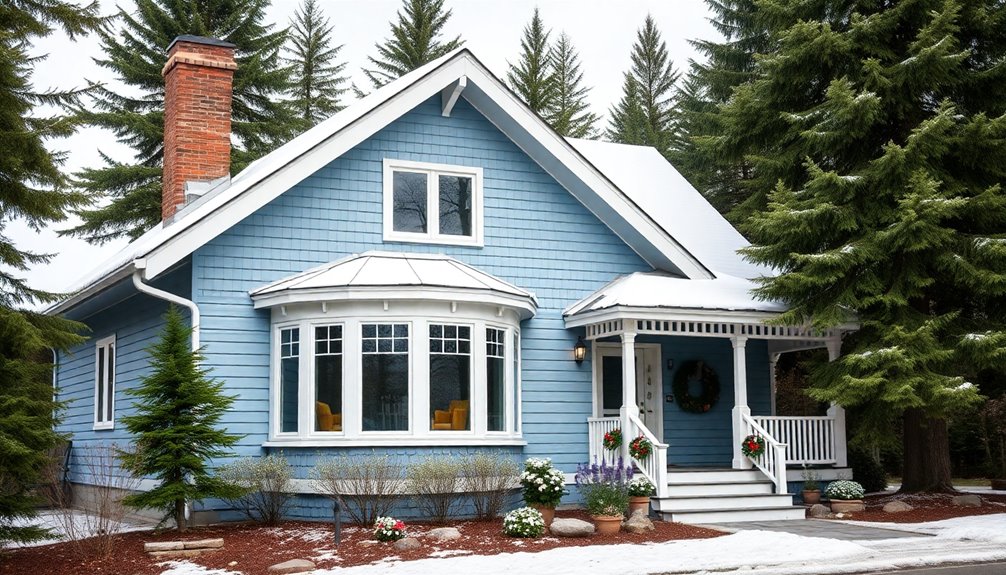
As you commence on the journey of home buying, it's crucial to contemplate various factors that influence your decision. Here are some key home buying considerations:
- Understand architectural styles like Bungalow, Victorian, and Modern to match your aesthetic preferences and lifestyle needs.
- Evaluate neighborhood factors, such as proximity to schools, parks, and amenities, ensuring it meets your family and social requirements.
- Don't skip home inspections; they can uncover potential issues impacting the home's value and safety.
- If you're a first-time homebuyer, explore financing options like the First Home Savings Account (FHSA) to help with your down payment.
- Stay informed about market trends and interest rates, as they directly affect mortgage affordability and your overall experience. Additionally, consider checking local listings for restaurant operating hours as they can influence your decision on neighborhood amenities.
Sustainable Features in Canadian Homes
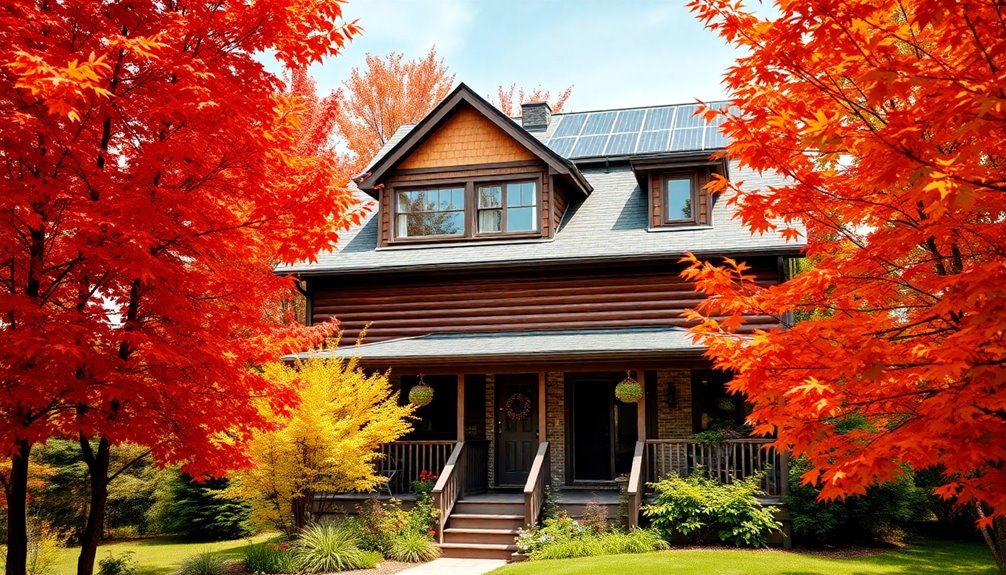
Sustainable features in Canadian homes are becoming essential for environmentally conscious buyers who want to reduce their carbon footprint. Many new constructions prioritize energy-efficient features like high-performance windows and insulation, which lower heating costs. You'll find sustainable materials, such as reclaimed wood, and environmentally friendly building products increasingly popular. Designs that maximize natural light and ventilation not only enhance comfort but also cut energy use. Urban homes often boast green roofs and rainwater harvesting systems, creating a harmonious balance with nature. Many buyers now seek properties with Energy Star ratings or LEED certification, reflecting the growing demand for eco-friendly living.
| Feature | Benefits |
|---|---|
| High-Performance Windows | Reduced heating costs |
| Sustainable Materials | Lower environmental impact |
| Natural Light | Improved indoor air quality |
| Green Roofs | Stormwater management |
| Energy Star Ratings | Assurance of energy efficiency |
Frequently Asked Questions
What Type of House Is Most Common in Canada?
If you're curious about the most common type of house in Canada, you'll find that bungalows are quite prevalent. Their single-story design and open floor plans make them popular among families and retirees alike.
Ranch-style homes also catch your eye, showcasing long, ground-level facades that emphasize accessibility.
In urban areas, modern and contemporary styles stand out with their clean lines and large windows, bringing in plenty of natural light for a bright, inviting atmosphere.
What Does a Canadian House Look Like?
Imagine a cozy retreat nestled among towering pines, where wood and brick come together to create warmth.
A Canadian house often features steep roofs and large windows, letting in the natural light. You might spot a charming bungalow or a modern home with clean lines.
Depending on where you are, you could see Colonial styles on the East Coast or sustainable designs on the West Coast. Each reflects the unique beauty of its surroundings.
How to Look at Homes in Canada?
When you're looking at homes in Canada, start by exploring different architectural styles to find what appeals to you.
Check out online listings and real estate platforms to compare prices and availability.
Don't forget to take into account regional differences; homes vary greatly across provinces.
Pay attention to energy-efficient features too, as many homes prioritize sustainability.
Finally, research local market trends and neighborhood amenities to guarantee you're making a smart investment.
What Is the Best Orientation for a House in Canada?
The best orientation for your house in Canada is south-facing. This maximizes sunlight exposure during the winter, helping to naturally heat your home and cut energy costs.
Consider including east-facing windows to capture morning light, while keeping west-facing windows in check to avoid overheating in the afternoons.
To enhance comfort, think about landscaping with deciduous trees that provide summer shade but allow sunlight in during winter months.
Conclusion
As you explore the diverse tapestry of Canadian homes, you'll find each style tells a story, echoing the land's rich history and vibrant culture. From cozy log cabins that hug the forest to sleek modern designs that embrace the skyline, every house reflects the heart of its region. When you step inside, you're not just entering a building; you're walking into a warm embrace of comfort and creativity, inviting you to create your own memories in this beautiful mosaic.









